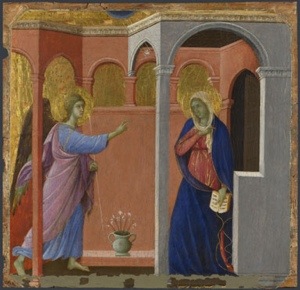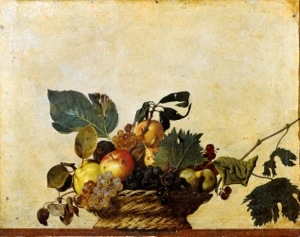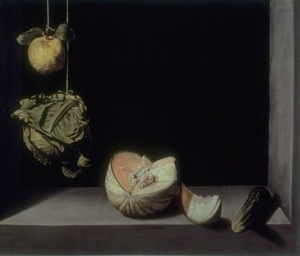I recently watched a BBC Scotland Arts Production programme aired on BBC4 on 5 January 2014 called Apples, Pears and Paint – How to make a Still Life Painting. Produced and directed by Liam Mcardle, narrated by Paul McGann
A fascinating look at the history of the still life genre, it’s place, both politically and in religious terms, throughout the centuries as well as a more indepth look at its structure, meaning and composition. This programme has had a positive and strong influence, making me think about still life & its role in todays society as well as my relationship with it.
Key statements were initially made..
Still life is about seeing
Still life asks us to stop and consider the world anew
To consider the pleasures of simple everyday life
Still life helps us to understand the beauty of nature and value the material world around us.
These statements are fundamentally easy to make and straight forward enough but by the end of the next hour and a half I really began to understand them and put them in to true context.
I had always assumed, rather naively perhaps, that still life had equal place in importance throughout history in relation to landscape, figurative and other mainstream genres of art, much as I consider it to be so in today’s modern world. But of course that simply isn’t true.
Art and paintings in Medieval times were generally reflections of the teachings of the Bible, most commonly commissioned by the Church. There was no place or room for still life. Objects were mostly used for symbolic purposes, for instance an apple would be intrinsically linked to Eve and the fall of Man as the Bible tells it, no one would look at that apple in a painting as an object of beauty or painted for the sake of itself alone. No object to be glorified according to the teachings of Christianity.
In 1307, Duccio’s Annunciation does take a first step toward still life with a vase of Lilies taking a central although slightly receding position in the painting. It remains full of symbolism of Mary’s virginal innocence but it nevertheless does make that initial step.
By the 16th Century the Church is still the main commissioner of art but now religious works begin to masquerade as still life, in some instances Christ, Jesus or other key figures being relegated to the background and a full still life composition becoming the main focus.
Still life continues to rise through Christianity and in 1596 Caravaggio paints Basket of Fruit, his one and only still life painting. It’s a simple basket loaded with fruit and vine leaves, all positioned right at the front of the painting. Andrew Graham-Dixon, author of Caravaggio: A Life Sacred and Profane goes on to point out the Basket of Fruit is full of highly charged dark symbolism, portraying death, eternal life and salvation through damaged and diseased fruit, withered vine leaves representing Christ. Its still full of religious connotations but it is the first true still life painting in its modern realistic form. It’s the first of its kind and people had no idea how to take it.
The 17th Century saw an explosion in still life and the setting for this golden age was Amsterdam. Through revolution the Dutch became a Republic, free from the Church and Monarchy and as such it’s art was called on to reflect its rapidly growing affluence and independence. The country became a super power, trading all over the world and as such things never before seen, such as exotic fruits, flowers and chinese porcelain etc were being bought back to the country. Wealth was the new focus and people wanted to display it through art.
Religion may not have been displayed in these still life images but the images themselves were still full of symbolism. Lobster, Crayfish, flowers such as Tulips were prominently featured. Tulips at the time were imported from Asia and one bulb could cost three times the price of a house so their pictorial value was extreme. These and other rare items were all bought into one fictional display, purely to show wealth, importance and affluence.
These coded displays of wealth, a natural desire to celebrate the county’s power, also bought with them a sense of associated guilt and skulls, bones, disarrayed tables with ripped tablecloths and other reminders of death and chaos crept in. Reminders that wealth could go as quickly as it came. These pieces became known as Vanitas paintings.
Larder pieces and paintings of other simple everyday objects also came into existence at this time. Juan Sanchez Cotan from Spain painted pieces of fruit or vegetables as he found them in the larder, some suspended in their concrete enclosure where they were kept to keep cool. He was a Realist painter, probably of monastic influence and he saw the beauty in these familiar but unimportant, simple and common objects.
By the 18th Century things were changing yet again for still life. The French Academy decided on rules of art determining that artists should be trained to paint figures and human action only so landscape and still life genres become the poor relations. Still life had to fight for recognition and one of the first artists to do so was John Baptiste Chardin.
Still life was considered simple without invention or imagination, just copy what was in front of the artist. But the artist John Baptiste (1699-1779) challenged this and he proved that it was just as difficult to paint still life as anything else and just as valuable.
They were right that still life is simple in one respect. The key to a great still life is simplicity which Chardin achieved. As well as managing to paint silence. His technique was to concentrate on only 2 or 3 ‘perches’ for the eye to land and focus on, the remainder of the painting was very slightly out of of focus. Chardin determined that a persons eye doesn’t see everything in high focus, just 2 or three things and so he painted all other things slightly off focus. His style is unique and no one ever saw or at least documented his technique. Chardin had the ability to make us see things around us that we’d forgotten to keep looking at.
The latter part of the 19th Century saw a revolution in art, started predominantly by Paul Cezanne (1839-1906). Born in Provence, France, he painted an interpretation of what he saw rather than actually always what was there in front of him, thus laying the foundation stones of change. During his lifetime many viewers of his work really couldn’t understand what they were seeing, so different was his interpretation to anything before. Light & Perception were key elements in Post-Impressionist art.
Still life in to the 20th Century was very much led by Renoir, Monet, Gauguin, all establishing a new language of still life. The impact of photography can be seen in Van Gogh’s work, bringing in texture, something photography could never do. Further still was the initial stages of Cubism, an exploration of still life from every aspect, sometimes from all angles at once. Further explored by Picasso and Braque for example still life became the base and out of that came chaos in a controlled manner.
Throughout the 20th and 21st Centuries there’s nothing more we like than ‘stuff’. Still life art in all forms helps us to really see the wood from the trees reminding us of the value of looking at the ‘stuff’ around us. This can be especially relevant today as we move toward a time when we have even more stuff around us, most of which we’ve never taken the time to really look at and value.
Still life continues to evolve today, still a contradiction but ever talking to us, work such as that produced by photographer Ori Gersht or London based artist Mat Collishaw always looking at the familiar & allowing us to discover depths within.




